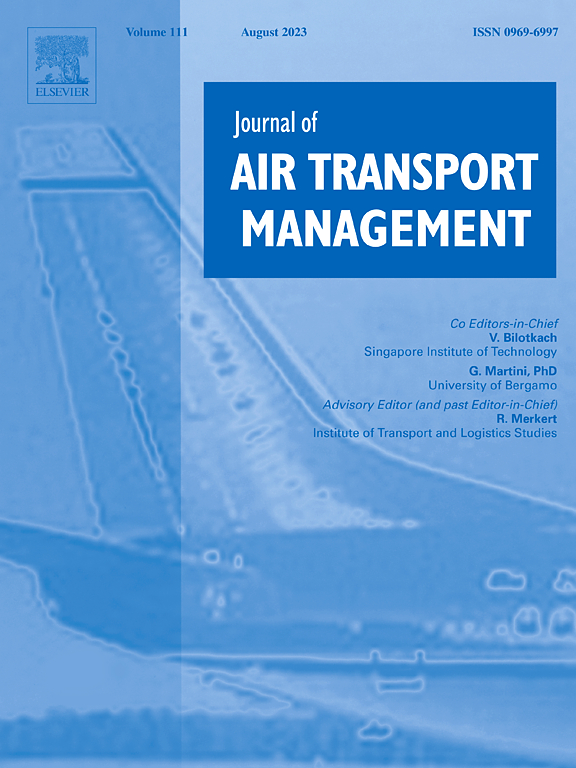Exploring prediction accuracy for optimal taxi times in airport operations using various machine learning models
IF 3.9
2区 工程技术
Q2 TRANSPORTATION
引用次数: 0
Abstract
Understanding delay conditions and making accurate predictions are essential for optimizing turnaround and taxi times, which in turn reduces fuel consumption and lowers CO2 emissions in airport operations. However, while existing research has explored the impact of various prediction models on airport operations, it often overlooks the performance of Collaborative Decision Making (CDM) variables when discussing delay conditions. The implementation of CDM at major European airports has led to a milestone-based approach within airport operations, particularly in the turnaround operations, segmenting these operations with unique features. The purpose of this paper is to systematically investigate the efficacy of various machine learning techniques, such as linear regression, regression trees, random forests, elastic nets, and multi-layer perceptrons (MLP), in accurately predicting delay categories within the CDM framework. For this purpose, we analyzed CDM operational data from Madrid Airport, with at least 166,185 flight observations. Our findings illustrate a training methodology on how different models vary in prediction accuracy when applied to CDM operational data. We applied the SHAP (SHapley Additive exPlanations) method for feature importance analysis of all our independent variables to interpret the output of our machine learning models. Our results indicate that linear regression and elastic nets are the most effective machine learning models for achieving high prediction accuracy within the CDM framework. To test their robustness, we extended the analysis with predictions for better schedule times for taxi times on arrival and depature for selected runways using a different dataset. Our results contribute by showcasing a training methodology, highlighting how elastic net model as the best-performing model can be adopted for turnaround operations. In conclusion, we discuss the implications of our results for runway demand policies and use of airport resources such as gate & runaway allocation.
利用各种机器学习模型探索机场运营中最佳滑行时间的预测精度
了解延误情况并做出准确预测对于优化周转和滑行时间至关重要,而优化周转和滑行时间又能减少机场运营中的燃油消耗和二氧化碳排放。然而,虽然现有研究已经探讨了各种预测模型对机场运营的影响,但在讨论延误情况时往往忽略了协同决策(CDM)变量的性能。欧洲主要机场实施 CDM 后,在机场运营中采用了基于里程碑的方法,特别是在周转运营中,将这些运营划分为具有独特功能的部分。本文旨在系统地研究各种机器学习技术(如线性回归、回归树、随机森林、弹性网和多层感知器(MLP))在 CDM 框架内准确预测延误类别的功效。为此,我们分析了马德里机场的 CDM 运行数据,其中至少包含 166,185 次航班观测。我们的研究结果说明了在 CDM 运行数据中应用不同模型时预测准确性差异的训练方法。我们采用 SHAP(SHapley Additive exPlanations)方法对所有自变量进行特征重要性分析,以解释机器学习模型的输出结果。我们的结果表明,线性回归和弹性网是在 CDM 框架内实现高预测精度的最有效机器学习模型。为了测试它们的稳健性,我们使用不同的数据集扩展了分析,对选定跑道的滑行到达时间和滑行结束时间进行了更好的预测。我们的结果展示了一种训练方法,突出了如何将弹性网模型作为表现最佳的模型用于周转运行。最后,我们讨论了我们的结果对跑道需求政策和机场资源(如登机口&)使用的影响;失控分配。
本文章由计算机程序翻译,如有差异,请以英文原文为准。
求助全文
约1分钟内获得全文
求助全文
来源期刊

Journal of Air Transport Management
TRANSPORTATION-
CiteScore
12.40
自引率
11.70%
发文量
97
期刊介绍:
The Journal of Air Transport Management (JATM) sets out to address, through high quality research articles and authoritative commentary, the major economic, management and policy issues facing the air transport industry today. It offers practitioners and academics an international and dynamic forum for analysis and discussion of these issues, linking research and practice and stimulating interaction between the two. The refereed papers in the journal cover all the major sectors of the industry (airlines, airports, air traffic management) as well as related areas such as tourism management and logistics. Papers are blind reviewed, normally by two referees, chosen for their specialist knowledge. The journal provides independent, original and rigorous analysis in the areas of: • Policy, regulation and law • Strategy • Operations • Marketing • Economics and finance • Sustainability
 求助内容:
求助内容: 应助结果提醒方式:
应助结果提醒方式:


